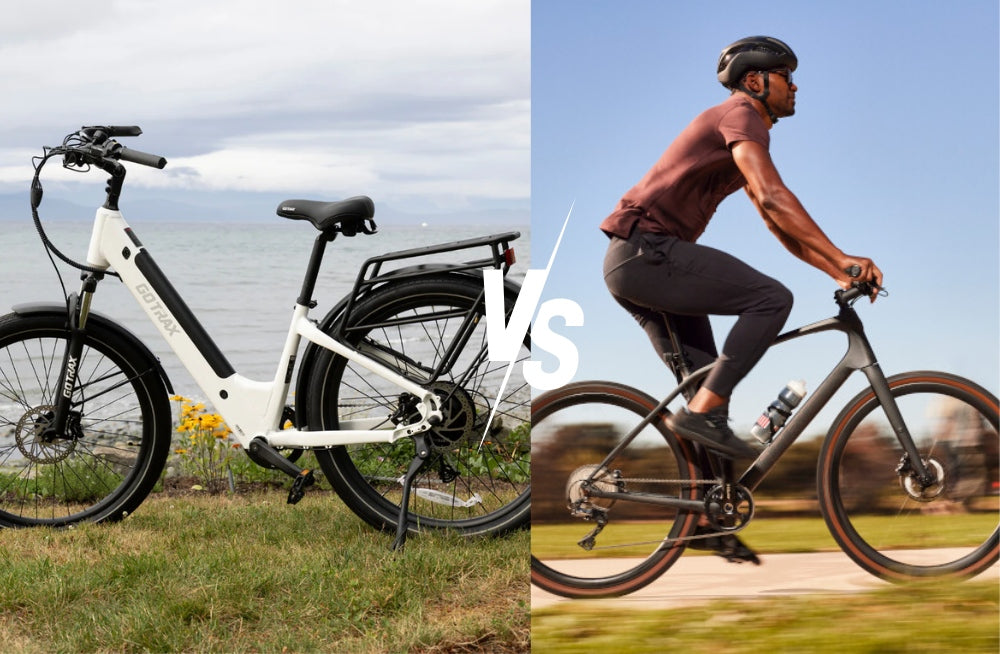When choosing a bicycle, many people often find themselves torn between a Hybrid Bike and an Electric Bike. These two types of bikes have distinct differences in design and functionality, so understanding their features and pros and cons will help you make an informed decision.
In this article, we’ll take a closer look at the differences between Hybrid Bikes and Electric Bikes, comparing their characteristics, and ideal use cases, and offer some buying recommendations.
What is a Hybrid Bike?

A hybrid bike is a bicycle that combines the features of both road bikes and mountain bikes. It is suitable for city riding and can also handle some light off-road riding.
Hybrid bikes typically come with wider tires, comfortable seats, and a more upright riding posture, making cycling easier and more comfortable.
Features of a Hybrid Bike:
- Tires: The tires are slightly wider, typically ranging from 28mm to 42mm, offering more grip than road bike tires but not as wide as those on mountain bikes.
- Frame: Lightweight design, ideal for city roads and light country paths.
- Riding Posture: The posture is more upright than a road bike, reducing fatigue during long rides.
- Speed and Comfort: Suited for moderate speeds, with a design that allows for extended comfort, making long rides less stressful.
- Braking System: Typically uses V-brakes or disc brakes, providing stable braking performance for safe cycling.
- Weight: Generally lighter than electric bikes, making it easier to handle.
What is an Electric Bike?

An Electric Bike is a bicycle equipped with an electric motor, primarily designed to assist the rider’s effort, reducing physical exertion and improving riding efficiency.
It combines the structure of a traditional bicycle with a modern electric drive system, making it an eco-friendly and convenient mode of transportation.
Features of an Electric Bike:
- Electric Assistance: Built-in battery and motor help assist while riding, reducing physical strain.
- Speed and Power: Typically faster than regular bicycles, especially on flat or uphill terrain.
- Range: The range of an electric bike usually falls between 30 to 100 km, depending on the battery size and riding conditions.
- Adjustable Assistance: Riders can adjust the level of electric assistance as needed, with different levels to suit various riding preferences.
- Design and Structure: Electric bikes generally resemble traditional bicycles but are equipped with components like a battery and motor, which may make them slightly heavier than regular bikes.
- Charging: The battery can be charged via an external power source, with charging times typically ranging from 4 to 6 hours.
Main Differences Between a Hybrid Bike and an Electric Bike

A hybrid bike offers a balance of speed and comfort, suitable for various riding styles, while an electric bike provides pedal assist to make commuting and hill climbing easier.
Let’s explore the differences between them in different aspects to help you choose the best bike for your daily transportation needs.
1. Power System
Hybrid Bike: Relies entirely on the rider's effort. While the frame and design make cycling easier, there is no electric assistance system, so the rider must power the bike themselves.
Electric Bike: Equipped with an electric assist system, allowing the rider to get help from the motor while pedaling, reducing physical exertion, especially on hills.
2. Suitable Use Cases
Hybrid Bike: Ideal for city riding, light off-road use, and short commutes. It handles both smooth city roads and less rugged countryside trails with ease.
Electric Bike: Better suited for longer commutes, hill climbing, or situations where quick arrival is needed. The electric assistance is particularly helpful for those who want to reduce the effort needed while riding, such as seniors or people with limited physical strength.
3. Weight
Hybrid Bike: Generally lighter, as it doesn’t have the extra weight of a battery or motor, making it easier to carry or transport.
Electric Bike: Due to the battery and motor, electric bikes are typically heavier. While modern electric bikes are becoming lighter, they are still heavier than hybrid bikes.
4. Price
Hybrid Bike: More affordable, typically priced lower than electric bikes. Prices for hybrid bikes range from 200 to 2000 CAD, depending on the brand and features.
Electric Bike: More expensive due to the cost of the motor and battery. Electric bike prices usually range from 500 to 5000 CAD, and can even go higher.
5. Maintenance Costs
Hybrid Bike: Maintenance is relatively low-cost, as it only requires regular upkeep for components like wheels, brakes, and the chain.
Electric Bike: Maintenance costs are higher, as the motor, battery, and other components need regular checks and occasional replacements. The battery typically lasts 2-5 years, and frequent use may require a replacement sooner.
How to Choose Between a Hybrid Bike and an Electric Bike?

Choosing between a hybrid bike and an electric bike Canada depends on your riding needs and budget. If you need a lightweight, economical bike for daily commuting, a hybrid bike might be more suitable for you. It’s ideal for those who don’t need much assistance while riding and have a limited budget.
If you plan on long-distance rides, especially uphill or on more challenging terrains, an electric bike is undoubtedly a better option. The electric assistance will significantly reduce your physical effort, providing more comfort, particularly during commuting or leisurely rides.
Conclusion
Whether you choose a hybrid bike or an electric bike, your decision should be based on your needs, budget, and riding habits. Each type of bike has its unique advantages and ideal use cases, so the most important thing is to find the one that suits you best.
If you're a beginner or have specific riding needs, it’s recommended that you visit a local shop to test-ride the bikes and consult with professionals to ensure you make the best choice.
Click to learn: Can You Get a DUI on a Bike?


